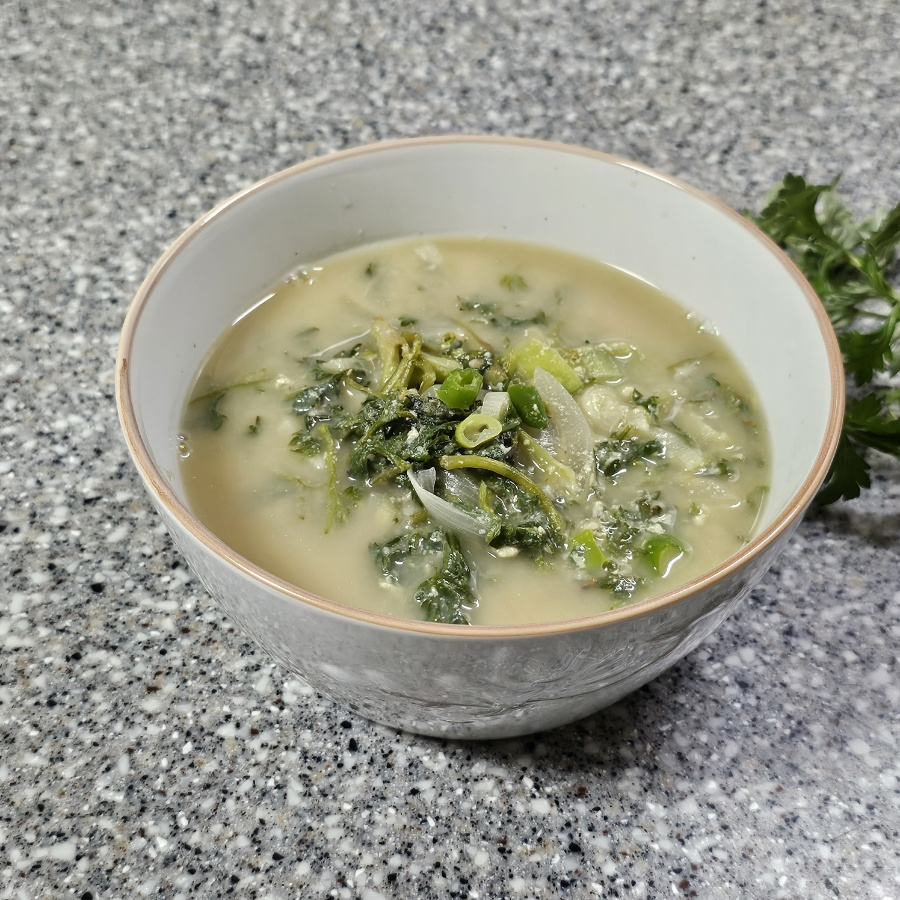Fragrant Mugwort Soup with Young Mugwort
Mugwort Soup: A Spring Delicacy for Health and Immunity

This recipe for mugwort soup (Ssukguk) is packed with the fresh aroma of spring and is known to help detoxify the body and prevent common adult diseases. Made with young mugwort, it offers a rich, savory flavor enhanced by rice water and soybean powder.
Mugwort Soup Ingredients- 1 bundle young mugwort (approx. 200g)
- 1/4 onion
- 1/4 white part of green onion
- 2 Cheongyang chili peppers
- 1/2 cup soybean powder
- 1 handful dried anchovies (for broth, about 20 fish)
Mugwort Soup Seasoning- 2 Tbsp doenjang (Korean soybean paste)
- 1/2 Tbsp minced garlic
- 2 Tbsp doenjang (Korean soybean paste)
- 1/2 Tbsp minced garlic
Cooking Instructions
Step 1
We’re going to make a delicious mugwort soup using young mugwort, which is a healthy food representing April. Young mugwort is particularly tender and fragrant this time of year, making it perfect for this soup.

Step 2
Here are the ingredients that will go into today’s mugwort soup. You’ll need: 1 bundle of young mugwort (about 200g), 1/4 onion, 1/4 of the white part of a green onion, 2 Cheongyang chili peppers, 1/2 cup of soybean powder, and a handful of dried anchovies (around 20) for the broth.

Step 3
First, gently remove any dirt or dark blemishes from the fresh mugwort. Then, rinse it thoroughly under cold running water, swishing it gently to wash away any soil or debris. Be careful not to scrub too hard, as the mugwort can be delicate.

Step 4
A secret ingredient for a truly delicious mugwort soup is rice water! After cooking rice, save the milky water from the third rinse. This will add a wonderful depth and subtle creaminess to the soup. If you don’t have rice water, a simple anchovy-kelp broth will also work well.

Step 5
Add 2 tablespoons of doenjang (Korean soybean paste) to the prepared rice water. It’s best to strain the doenjang through a sieve to ensure it dissolves smoothly without clumps, resulting in a clean and refined broth.

Step 6
Add the handful of dried anchovies (about 20 fish) to the broth and bring it to a rolling boil over high heat to extract their flavor. To prevent any fishy taste, it’s advisable to remove the anchovies once the broth starts boiling vigorously.

Step 7
When making soup with fragrant greens like mugwort or chive, adding a bit of soybean powder not only complements their natural aroma but also adds a rich, savory depth. It truly elevates the flavor of the mugwort.

Step 8
Gently coat the mugwort with the soybean powder. Toss it lightly with your hands to ensure the powder evenly adheres to the mugwort leaves without clumping. This ‘coating’ will create a wonderfully savory broth when cooked.

Step 9
Add the soybean-powder-coated mugwort to the boiling broth. Initially, maintain a high heat to help the mugwort wilt and the flavors meld together.

Step 10
Once the mugwort has softened slightly, stir in 1/2 tablespoon of minced garlic, along with the chopped Cheongyang chili peppers and the white parts of the green onion. Let it simmer briefly. The doenjang and minced garlic usually provide sufficient seasoning, but if you prefer it saltier, you can add a pinch of salt to taste. Your delicious and slightly spicy mugwort soup is now ready!

Step 11
While it’s a common dish, a bowl of mugwort soup feels like a nourishing tonic, bringing a sense of healing to every part of your body. It feels like impurities are being flushed out, leaving a healthy energy. This young mugwort soup is savory and wonderfully aromatic, lifting your spirits and leaving you feeling satisfyingly full. Even with the sudden chill in the air, enjoy a warm bowl of this soup, dress warmly, and embrace the vibrant spring ahead! Spring is just around the corner.




